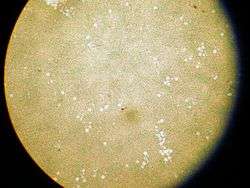Azomonas
Azomonas species are typically motile, oval to spherical, and secrete large quantities of capsular slime. They are distinguished from Azotobacter by their inability to form cysts, but like Azotobacter, they can biologically fix nitrogen under aerobic conditions (diazotrophs).
| Azomonas | |
|---|---|
 | |
| Azmonas under 100x oil immersion | |
| Scientific classification | |
| Kingdom: | |
| Phylum: | |
| Class: | |
| Order: | |
| Family: | |
| (unranked): | Azotobacter group |
| Genus: | Azomonas Winogradsky, 1938 |
| Species | |
|
Azomonas agilis | |
Bacteria of the genus Azomonas are known to form intracellular inclusions of polyhydroxyalkanoates under certain environmental conditions (e.g. lack of elements such as phosphorus, nitrogen, or oxygen combined with an excessive supply of carbon sources).
Etymology
The name Azomonas derives from:
- New Latin noun azotum [from Fr. noun azote (from Greek prep. ά, a, not; Greek noun ζωή, zōē, life; Greek noun άζωη, azōē, not sustaining life)], nitrogen; New Latin azo-, pertaining to nitrogen; Latin monas (μονάς), nominally meaning "a unit", but in effect meaning a bacterium; New Latin Azomonas, nitrogen monad.[1]
Members of the genus Azomonas can be referred to as azomonads (viz. Trivialisation of names).
gollark: Possibly Good Stuff:* TypeScript - your code can actually be typechecked reasonably well* React - very nice declarative rendering of stuff* async/await - whilst not as good as monadic whatevers, it does make asynchronous stuff much nicer* Ramda - very nice functional utilities
gollark: I do quite like *some* of JS, just not... most?
gollark: We need this in a library; people can't implement this on their own without being professional developers.
gollark: And, well, `x % 2 === 0` is also astoundingly complex. I mean, look at that weird squiggly confusing thing that very senior, experienced developers call "modulus"!
gollark: As we all know, `typeof x === "number"` is so very complicated that to ensure people can do it easily - without getting it wrong by falling into one of many, many pitfalls - it has to be in a library.
References
- Azomonas entry in LPSN [Euzéby, J.P. (1997). "List of Bacterial Names with Standing in Nomenclature: a folder available on the Internet". International Journal of Systematic and Evolutionary Microbiology. 47 (2): 590–2. doi:10.1099/00207713-47-2-590. PMID 9103655.]
This article is issued from Wikipedia. The text is licensed under Creative Commons - Attribution - Sharealike. Additional terms may apply for the media files.